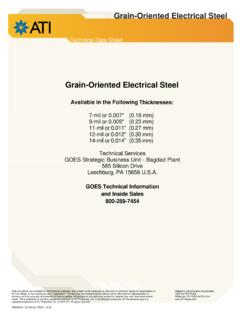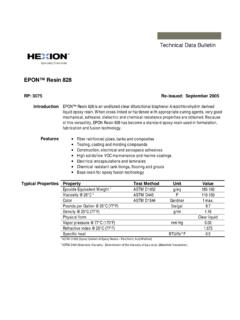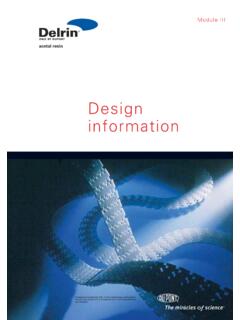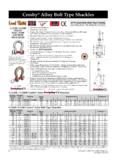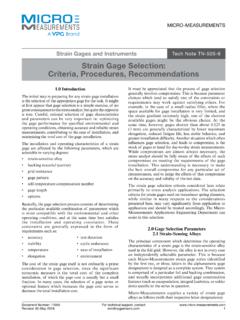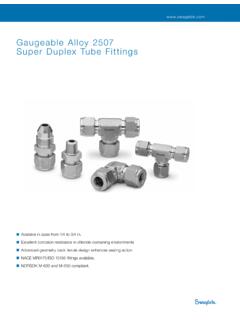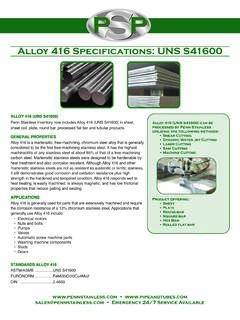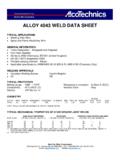Transcription of TITANIUM ALLOY GUIDE - spacematdb.com
1 CompanyAn RTI International Metals, Inc. CompanyTITANIUM ALLOY GUIDECONTENTSPageIntroduction - Facts About Titaniumand the Periodic Table .. 1 Why Select TITANIUM alloys ? .. 2-5 GUIDE to Commercial TITANIUM alloys andTheir Mill Product Forms .. 6-7 Basic TITANIUM Metallurgy .. 8-9 Machining TITANIUM .. 10-11 Forming TITANIUM .. 12-14 Welding TITANIUM .. 14-15 Properties of CommerciallyPure TITANIUM and TITANIUM alloys .. 16-36 Guaranteed Minimum PropertiesRMI 6Al-4V ALLOY Products .. 37 Properties After Heat Treatmentof Various RMI TITANIUM alloys .. 38-42 RMI Service and ISO Approvals .. 43 References .. 44 RMI Capabilities .. 4522 TiPROPERTIES OF PURE ELEMENTAL TITANIUMAT ROOM TEMPERATUREATOMICNUMBERBOILING POINT CMELTING POINT CDENSITYATOMICWEIGHTOXIDATION (Ar)3d24s2 Titaniumhcp Crystal StructureLattice Parametersc= nma= nmAtomic cm3/molCovalent ColorDark GreyHardness70 to 74 BHNC oefficient of x 10-6/ CElectrical Resistivity42 ohm-cmThermal Conductivity20 W/m KHeat of Fusion292 kJ/kgHeat of MJ/kgSpecific Heat518 J/kg KMagnetic x 10-6 cm3/gMagnetic of Elasticity100 GPaPoisson's CBeta Transus CThermal Neutron AbsorptionCross Pauling' ,3 Cover and BackPhoto Descriptions1.
2 Heat Exchangers2. Offshore DrillingPlatform3. F-22 Fighter4. RecreationalApplications5. CommercialAerospace6. Medical Implants7. AutomotiveApplications8. Naval publication is alsoavailable for viewing orreproduction purposeson our website ALLOY GUIDEINTRODUCTIONThe information provided on the following pages is intended for reference details can be obtained by contacting the Technical staff of RMIT itanium Company through its Sales Department or through the website has been recognized as anelement (Symbol Ti; atomic number 22;and atomic weight ) for at least 200years. However, commercial productionof TITANIUM did not begin until the1950 s. At that time, TITANIUM wasrecognized for its strategic importanceas a unique lightweight, high strengthalloyed, structurally efficient metal forcritical, high-performance aircraft, suchas jet engine and airframe worldwide production of thisoriginally exotic, Space Age metaland its alloys has since grown to morethan 50 million pounds metal sponge and millproduct production capacity andefficiency, improved manufacturingtechnologies, a vastly expanded marketbase and demand have dramaticallylowered the price of TITANIUM , TITANIUM alloys are common,readily available engineered metals thatcompete directly with stainless andspecialty steels, copper alloys .
3 Nickel-based alloys and the ninth most abundant element inthe Earth s Crust and fourth mostabundant structural metal, the currentworldwide supply of feedstock ore forproducing TITANIUM metal is virtuallyunlimited. Significant unusedworldwide sponge, melting andprocessing capacity for TITANIUM canaccommodate continued growth intonew, high-volume applications. Inaddition to its attractive high strength-to-density characteristics for aerospaceuse, TITANIUM s exceptional corrosionresistance derived from its protectiveoxide film has motivated extensiveapplication in seawater, marine, brineand aggressive industrial chemicalservice over the past fifty years. Today, TITANIUM and its alloys are extensivelyused for aerospace, industrial andconsumer applications.
4 In addition toaircraft engines and airframes, titaniumis also used in the followingapplications: missiles; spacecraft;chemical and petrochemicalproduction; hydrocarbon productionand processing; power generation;desalination; nuclear waste storage;pollution control; ore leaching andmetal recovery; offshore, marine deep-sea applications, and Navy shipcomponents; armor plate applications;anodes, automotive components, foodand pharmaceutical processing;recreation and sports equipment;medical implants and surgical devices;as well as many other booklet presents an overview ofcommercial TITANIUM alloys offered byRMI TITANIUM Company. The purposeof this publication is to providefundamental mechanical and physicalproperty data, incentives for theirselection, and basic guidelines forsuccessful fabrication and technical information can befound in the sources referenced in theback of this booklet.
5 Furtherinformation, assistance, analysis andapplication support for TITANIUM and itsalloys, can be readily obtained bycontacting RMI TITANIUM Companyheadquartered in Niles, Ohio, USA, orany of its facilities and officesworldwide listed in this Ce59 Pr60 Nd61 Pm62 Sm63 Eu64 Gd65 Tb66 Dy67 Ho68 Er69 Tm70 Yb71 Lu90 Th91 Pa92 U93 Np94 Pu95 Am96 Cm97 Bk98 Cf99 Es100 Fm101 Md102 No103 LrPERIODIC TABLE1 H2 He3 Li4 Be5 B6 C7 N8 O9 F10 Ne11 Na12 Mg13 Al14 Si15 P16 S17 Cl18 Ar19 K20 Ca21 Sc V24 Cr25 Mn26 Fe27 Co28 Ni 29 Cu 30 Zn31 Ga32 Ge33 As34 Se35 Br36 Kr37 Rb38 Sr39 Y40 Zr41 Nb42 Mo43 Tc44 Ru45 Rh46 Pd 47 Ag 48 Cd49 In50 Sn51 Sb52 Te53 I54 Xe55 Cs56 Ba57 La72 Hf73 Ta74 W75 Re76 Os77 Ir78 Pt 79 Au 80 Hg81 Tl82 Pb83 Bi84 Po85 At86 Rn87 Fr88 Ra89 Ac104 Rf105 Db106 Sg107 Bh108 Hs109 Mt110 Uun22 TiTITANIUM ALLOY GUIDE2 WHY SELECT TITANIUM alloys ?
6 Attractive Mechanical PropertiesTable 1. Primary Attributes of TITANIUM alloys Elevated Strength-to-Density Ratio (highstructural efficiency) Low Density (roughly half the weight ofsteel, nickel and copper alloys ) Exceptional Corrosion Resistance(superior resistance to chlorides,seawater and sour and oxidizingacidic media) Excellent Elevated TemperatureProperties (up to 600 C (1100 F)) TITANIUM and its alloys exhibit a uniquecombination of mechanical andphysical properties and corrosionresistance which have made themdesirable for critical, demandingaerospace, industrial, chemical andenergy industry service. Of the primaryattributes of these alloys listed in Table1, TITANIUM s elevated strength-to-Figure 1 Figure 2 Figure 3 Figure 41008060402001031051091070400600200Ti6Al -4 VAirSteamNaCl SolutionAir12 Cr SteelNaCl Solution12 Cr SteelCycles to Failure(MPa)Cyclic StressAmplitude(ksi)density represents the traditionalprimary incentive for selection anddesign into aerospace engines andairframe structures and exceptional corrosion/erosionresistance provides the primemotivation for chemical process,marine and industrial use.
7 Figure 1reveals the superior structural efficiencyof high strength TITANIUM alloyscompared to structural steels andaluminum alloys , especially as servicetemperatures increase. TITANIUM alloysalso offer attractive elevatedtemperature properties for applicationin hot gas turbine and auto enginecomponents, where more creep-resistant alloys can be selected fortemperatures as high as 600 C (1100 F)[see Figure 2].The family of TITANIUM alloys offers awide spectrum of strength andcombinations of strength and fracturetoughness as shown in Figure 3. Thispermits optimized ALLOY selection whichcan be tailored for a critical componentbased on whether it is controlled bystrength and S-N fatigue, or toughnessand crack growth ( , critical flaw size)in service.
8 TITANIUM alloys also exhibitexcellent S-N fatigue strength and lifein air, which remains relativelyunaffected by seawater (Figure 4) andother environments. Most titaniumalloys can be processed to provide highfracture toughness with minimalenvironmental degradation ( , goodSCC resistance) if required. In fact, the3 TITANIUM ALLOY GUIDEF igure 5lower strength TITANIUM alloys aregenerally resistant to stress corrosioncracking and corrosion-fatigue inaqueous chloride pressure-critical components andvessels for industrial applications, TITANIUM alloys are qualified undernumerous design codes and offerattractive design allowables up to315 C (600 F) as shown in Figure common pressure design codesinclude the ASME Boiler and PressureVessel Code (Sections I, III, and VIII),the ANSI (ASME)
9 PressureCode, the BS-5500, CODAP,Stoomwezen and Merkblatt EuropeanCodes, and the Australian AS 1210 andJapanese JIS and Erosion ResistanceTitanium alloys exhibit exceptionalresistance to a vast range of chemicalenvironments and conditions providedby a thin, invisible but extremelyprotective surface oxide film. This film,which is primarily TiO2, is highlytenacious, adherent, and chemicallystable, and can spontaneously andinstantaneously reheal itself ifmechanically damaged if the leasttraces of oxygen or water (moisture) arepresent in the environment. This metalprotection extends from mildlyreducing to severely oxidizing, andfrom highly acidic to moderatelyalkaline environmental conditions; evenat high temperatures.
10 TITANIUM isespecially known for its elevatedresistance to localized attack and stresscorrosion in aqueous chlorides ( ,brines, seawater) and other halides andwet halogens ( , wet Cl2 or ), and to hot, highly-oxidizing,acidic solutions ( , FeCl3 and nitricacid solutions) where most steels,stainless steels and copper- and nickel-based alloys can experience severeattack. TITANIUM alloys are alsorecognized for their superior resistanceto erosion, erosion-corrosion,cavitation, and impingement in flowing,turbulent fluids. This exceptionalwrought metal corrosion and erosionresistance can be expected incorresponding weldments, heat-affected zones and castings for mosttitanium alloys , since the sameprotective oxide surface film is useful resistance of TITANIUM alloysis limited in strong, highly-reducing acidmedia, such as moderately or highlyconcentrated solutions of HCl, HBr,H2SO4, and H3PO4, and in HF solutionsat all concentrations, particularly astemperature increases.
